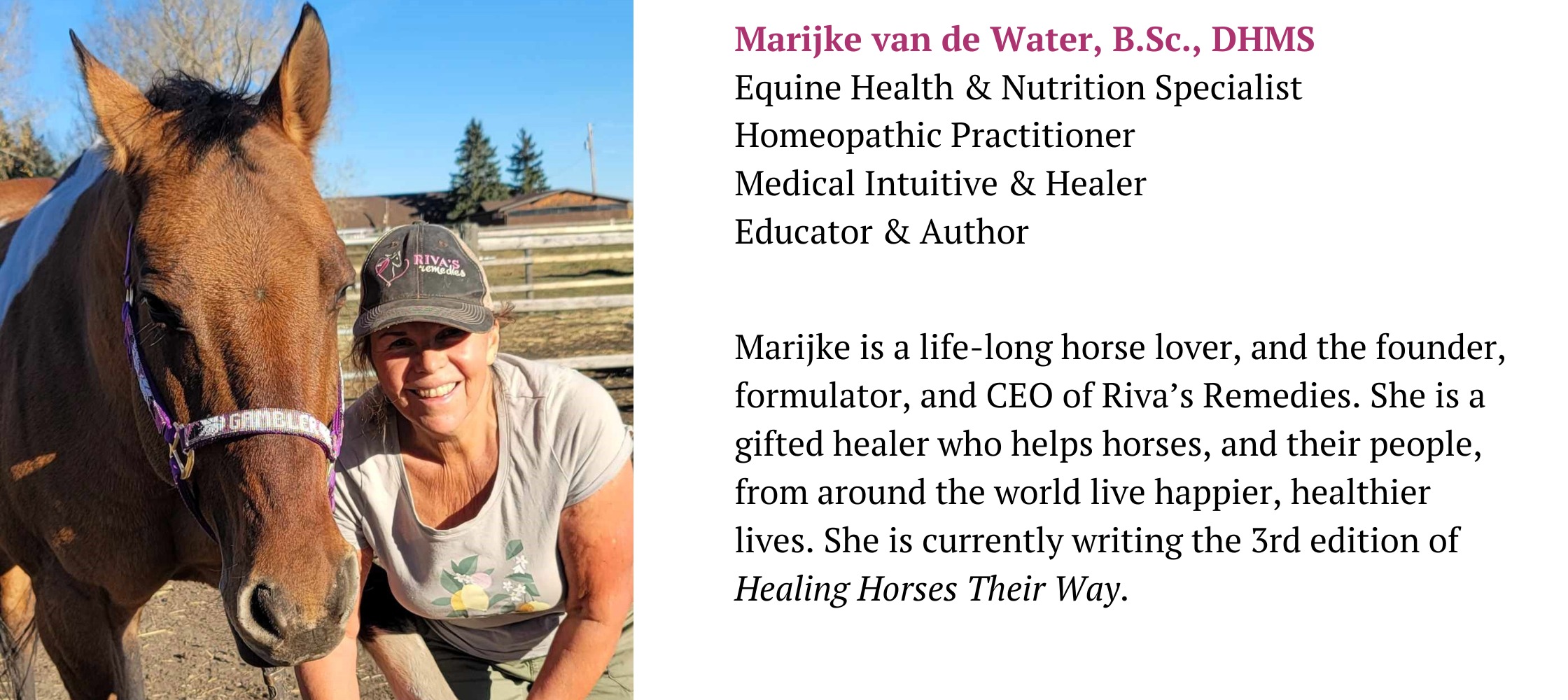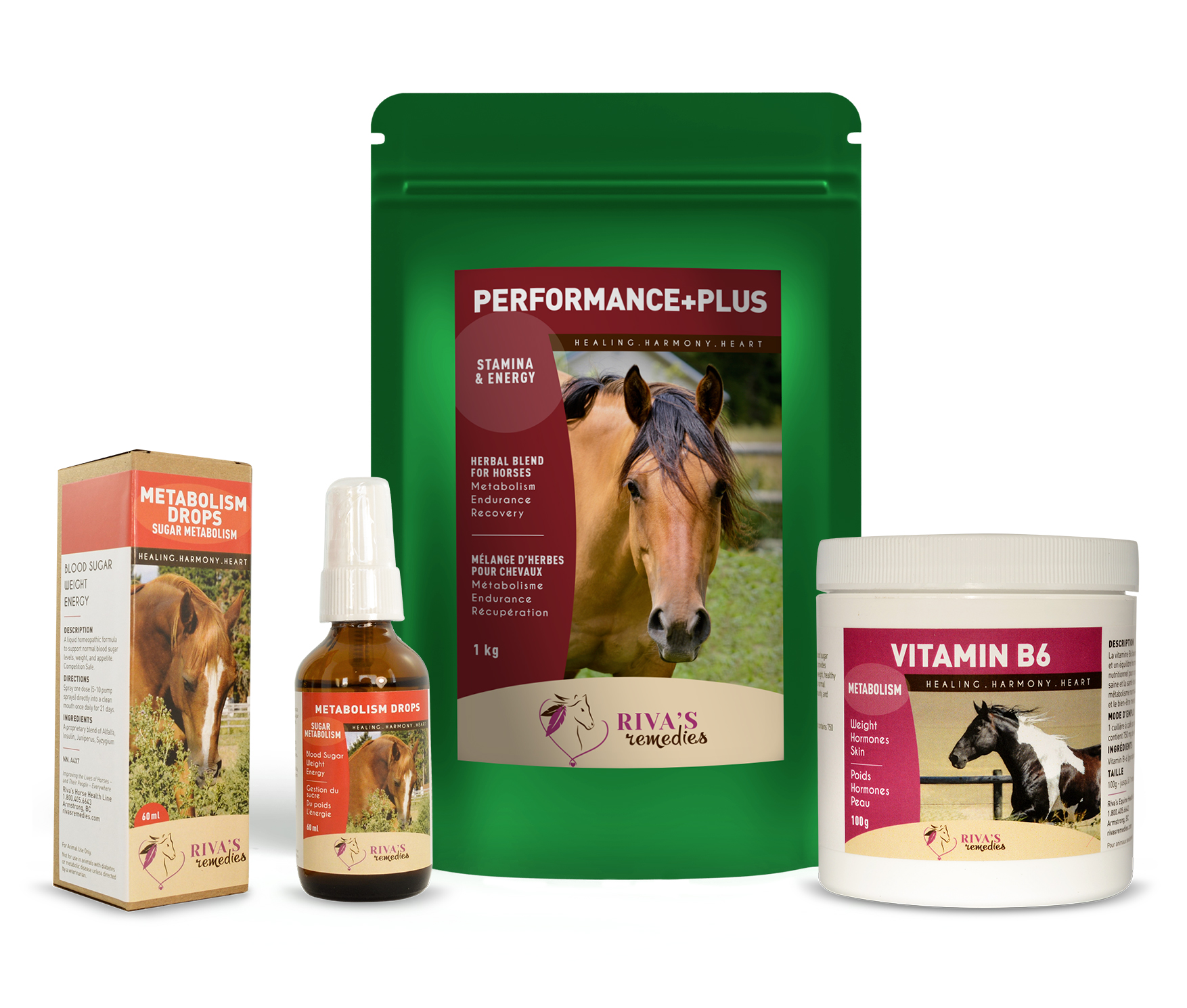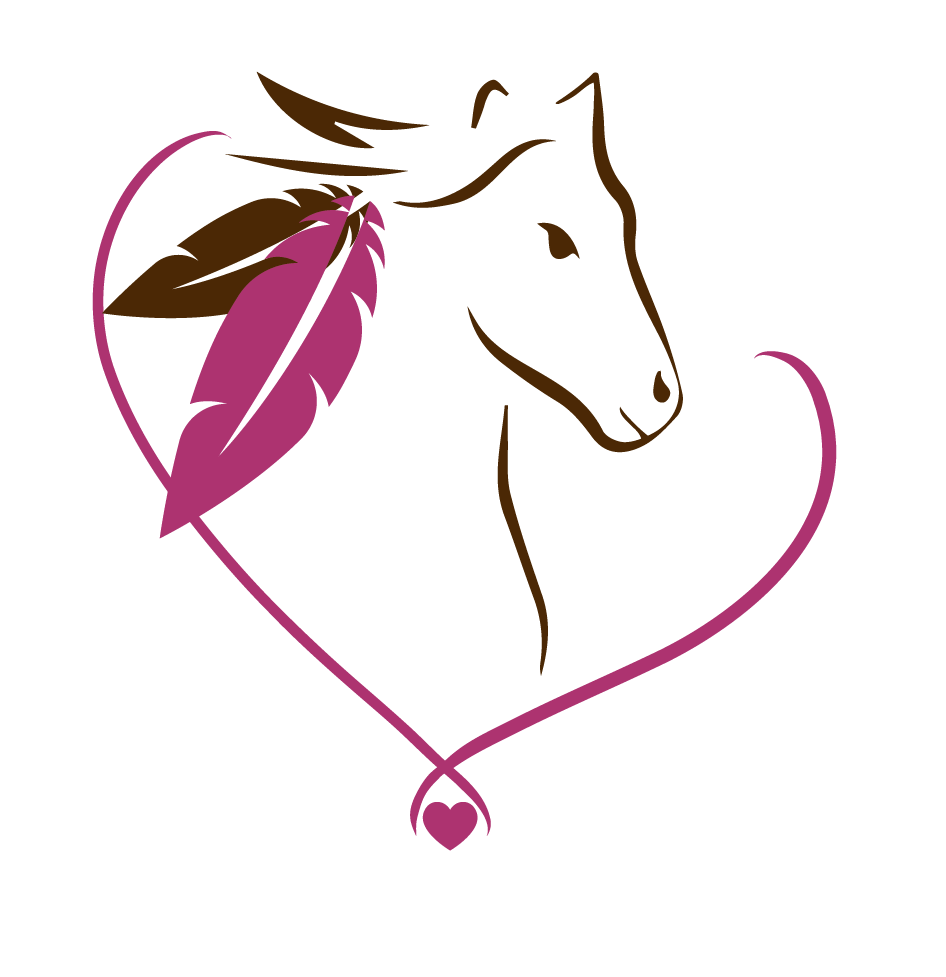With spring well under way many horse people are preparing to transition their horses from an all-hay winter diet to the lush spring grass which the horses can’t wait to dive into. But we have learned, over the last couple of decades, that our domestic pastures are not what they used to be. And since many equine diseases are associated with high sugar diets, a lot of people are limiting grass grazing for their horses or eliminating it altogether.
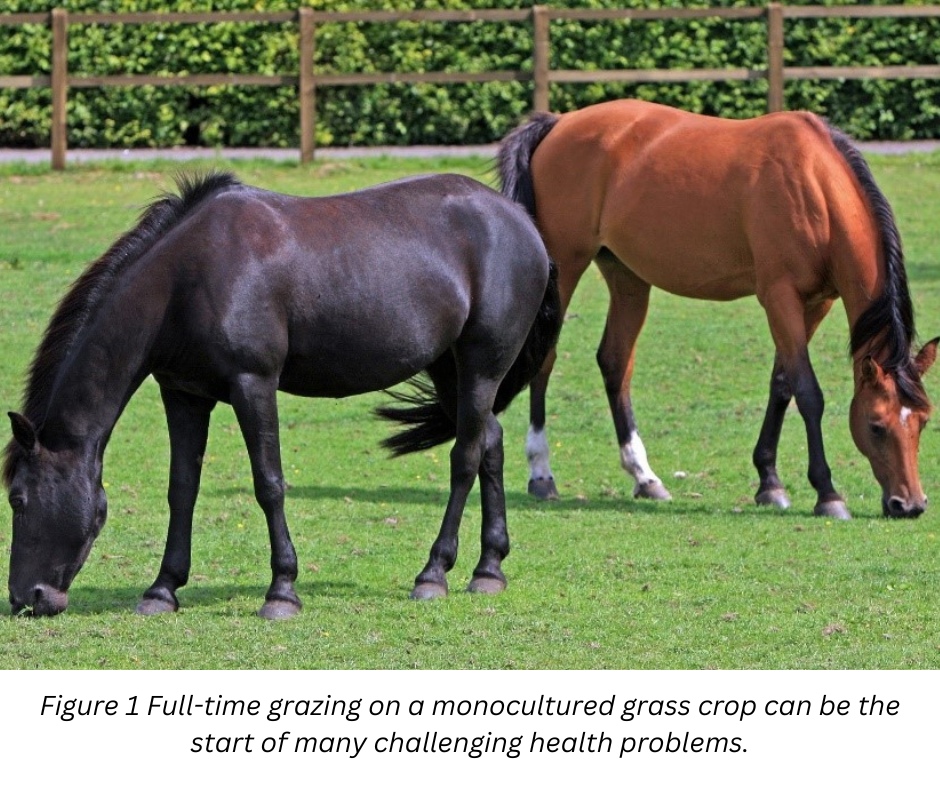
What’s In Our Grass Pastures?
It used to be that the grass pastures were more suitable for our horses. But the quality has changed a lot because of the different seed mixes and the various growing conditions. Fields, at one time, used to consist of native prairie grasses and slow growing bunch grasses. But the grass fields now are grown as monoculture crops with little diversity. Instead of a variety of different grasses, plants, and shrubs which provide a plethora of nutrients, minerals, and fibre, the horses are eating one type of grass which contains less nutrition, more sugar, and the addition of fructan starches.
Fructans found their way into the crops because in the late 1980’s forage researchers began to focus on “Relative Feed Value” which led them to design grass species which were higher in starch content; they wanted a high starch grass to fatten up the cows to increase meat and milk production. These high starch grasses were designed to be nutrient dense, high in energy, palatable, and resistant to climate extremes and tolerant to artificial fertilizers. They also contained more sugar for palatability and weight gain and were lower in fibre which kept the cattle hungry prompting them to eat more. The cows didn’t appear to have any problems digesting this new fructan starch, but the horses were another story.
Somewhere along the way, the plant scientists forgot that horses would be eating the same grass and hay as the cows, and that these new grasses would be problematic for our horses. Why? Because horses don’t digest fructans well at all.
How Is Grass Affecting Our Horses?
The primary problem is the high levels of dietary sugars which cause a horse’s blood sugar to rise during or after eating. Sugar requires insulin secreted by the pancreas to open up glucose receptors in the muscles and the liver. This allows the sugars to move quickly out of the blood and into the tissues where it is used for energy or for storage. Normally sugars are stored in the muscles and liver as glycogen, which is the storage form of sugar. From here the glycogens are converted back into sugar and released into the blood again when needed for energy. However, when the muscles and liver storage depots are full the receptors become resistant to insulin and will therefore not open to allow the sugars entry into the tissues. Sugars which cannot be stored as glycogen must now try and convert to fat instead. But with a continuing diet that is high in sugar, especially for horses that don’t get enough exercise, insulin receptors become more resistant and the insulin in response continues to rise, as does the body weight. This condition is known as Insulin Resistance (IR).
But IR is responsible for more than just weight gain. Poor immunity, fatigue, thirst, increased appetite, increased
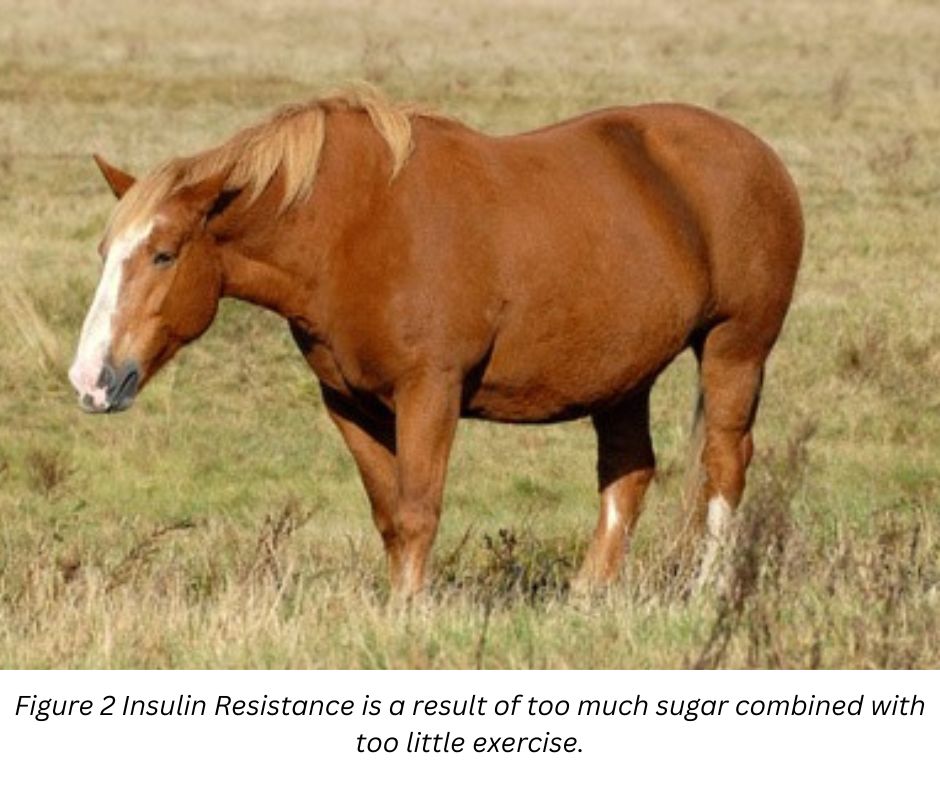
urination, general inflammation, edema, and body soreness are all signs of sugar toxicity. And, perhaps most significantly laminitis has now become an epidemic mostly due to the destructive effects of sugar and insulin on hoof tissue.
High sugar diets including grass make it impossible for these sore horses to become sound even with good trimming practices. Many IR horses eventually develop PPID (Cushing’s Syndrome) which adds new symptoms and complicates laminitis due to the hormone imbalances.
Fructans, on the other hand, don’t raise insulin and blood sugar levels but they cause digestive toxicity. Horses digest all of their food including carbohydrates, proteins, and fats, in the stomach and small intestine. Only fibre is passed into the hindgut where it ferments to produce energy and is the reason why horses need so much fibre in their diets. And since fructan is a starch, it should be digested in the small intestine as well. However, horses don’t have enough amylase (a digestive enzyme that digests starches) to digest it so the fructans are passed into the hindgut where they ferment instead. And because only fibre should be fermented in the hindgut the excess fermentation of results in toxins, acids (low pH), heat, gas, mal-digested debris, pathogenic bacteria, and more parasites. It also depletes the friendly bacteria (probiotics) and disturbs the hindgut microbiome.
This eventually causes cecal acidosis, aka leaky gut, which then damages the colon membranes and leaks toxins and acids into the general system. Leaky gut is frequently responsible for immune breakdown, skin problems, sore joints, respiratory symptoms, allergies, and fatigue. And given that leaky gut is a significant contributor to laminitis, fructan starches are a strong risk factor. Fructan levels are also high in wheat, barley, and rye which is another reason to not feed these grains nor their grasses to horses.
Smart Grazing
Sugars and fructans are highest in the grass in the spring — April, May, and June. They are also high during the daytime since sunlight stimulates the photosynthetic process to produce sugars. During the night, photosynthesis shuts off and any stored starches are used up by the plant. Therefore, by early morning the grass is much lower in sugars, making this an optimum time for horses to graze. “Graze your ponies in the early hours” the old horse folks used to say. By afternoon, the sugars are at peak levels again. And cloudy days will produce less sugar than sunny days.
Sunny days and frosty nights, common in the fall, can also be an issue because sugar production during the day combined with the colder, frosty nights stunt the normal growth of the plants which then use up less sugar. Warmer, sunny days promote photosynthesis but if the temperature is below 5°C at night, there is no plant growth at all. No sugars are used, and so the concentrations remain high leaving more sugar available for the grazing animal. Therefore, it may be necessary to avoid grazing until it is frosty during the day as well so there is less production of sugars.
Nevertheless, fall sugars will never be as high as the sugar content in the young, lush grass crops in the spring which is the season that causes the most adverse health consequences including weight gain, crested necks, fat pads, inflammation, and laminitis.
Pastures that are overgrazed, dry, under-fertilized, depleted, or stressed in any way are a problem too because these factors will stunt the growth of the plant so that it is not consuming the sugars for growth. And keep your eye on the overconsumption of dandelions and clover since those tend to be higher in sugar as well.
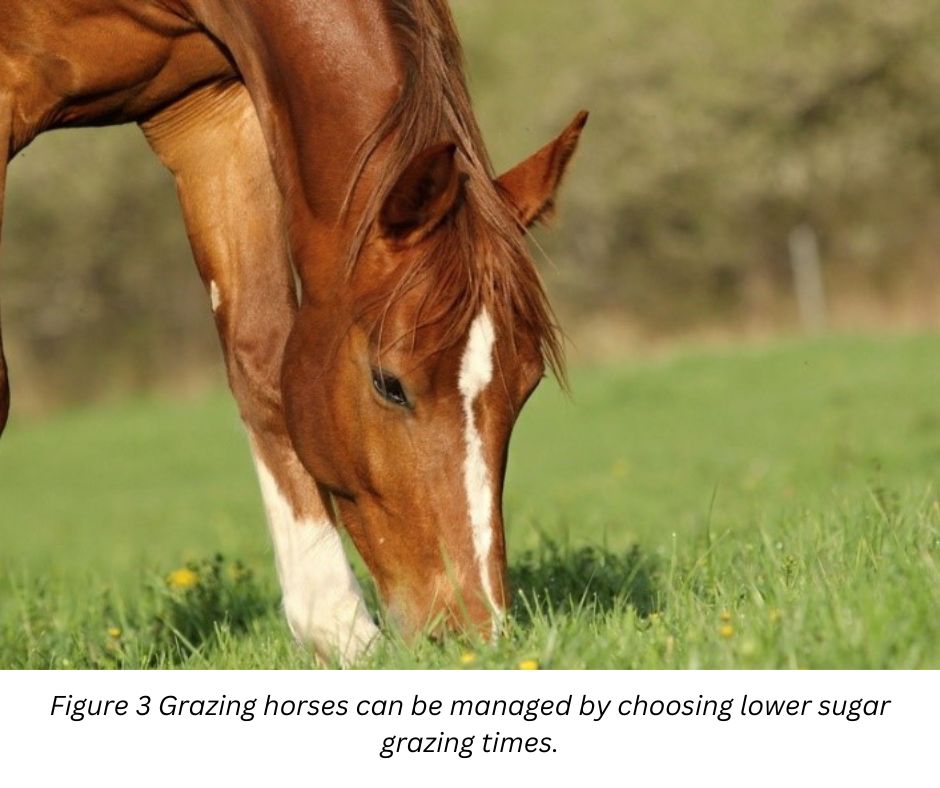 Allowing horses to graze in taller grasses can reduce fructan consumption since the horses will nip off the top of the plant rather than the bottom stems, where most of the fructans are stored. But they will also seize the opportunity and eat a lot more and so may very well end up ingesting high dietary sugars.
Allowing horses to graze in taller grasses can reduce fructan consumption since the horses will nip off the top of the plant rather than the bottom stems, where most of the fructans are stored. But they will also seize the opportunity and eat a lot more and so may very well end up ingesting high dietary sugars.
Rain after a drought provides optimal conditions for grass growth as the warm wet weather and bright sunshine promote rapid growth. Rain can make for grass that is higher in water than sugar, which is good, but the fructans previously found in the stem during the drought will now be used for leaf growth. This makes the starches more available to the grazing horses. So, watch for metabolic symptoms during a rainstorm after a drought.
How much grass grazing a horse can tolerate is variable and depends on breed, level of exercise, lifestyle, health history, grass type, and the local climate. Some horses cannot be free grazed at all while most others should be limited and regularly exercised and correctly trimmed. Some horses are turned out for short periods of time at the same time every day, but this may lead to gorging even if they have hay available. Plan your horses’ grazing times based on their individual habits.
The Importance of Probiotics
Sugar, fructan, and lack of fibre unbalance the microbiome by reducing the numbers of healthy bacteria, i.e., probiotics, and increasing the unhealthy bacteria.
The process of fermentation is accomplished with billions of units of various strains of bacteria. Horses, perhaps more than any other species, rely on a high level of probiotics to maintain a balanced microbiome in the gut and to ferment fibre for energy. A deficiency of probiotics can cause bloating, colic, diarrhea, leaky gut, poor intestinal immunity, unhealthy weight loss or gain, and poor nutrient absorption. Thus, in all cases of digestive problems, Insulin Resistance, poor immunity, and laminitis, horses will benefit from a good quality probiotic. Probiotics should also be replenished for horses on pasture because high sugar diets deplete probiotics more quickly than hay only diets.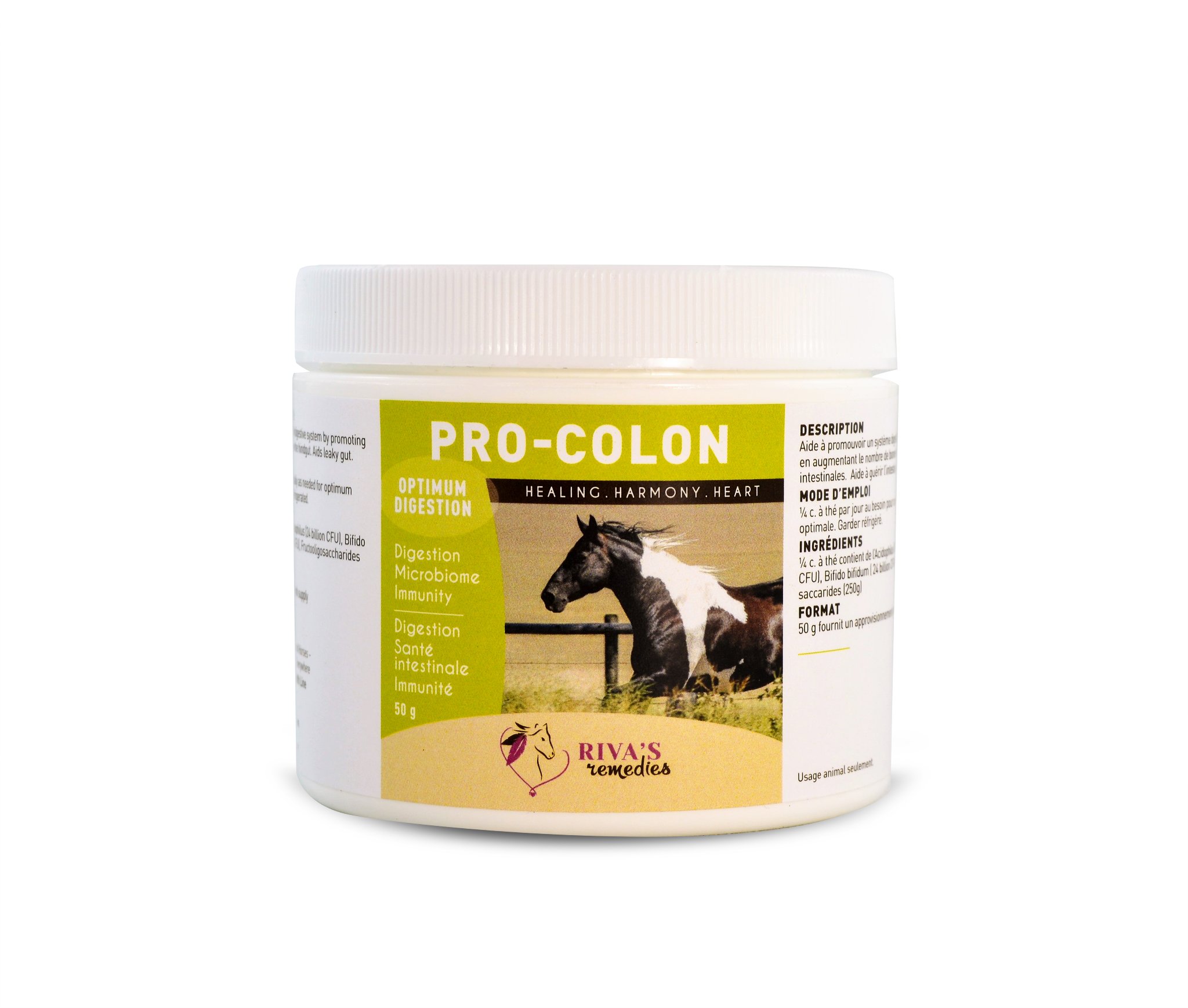
The best quality probiotics are those that need refrigeration since “cold” probiotics ensure maximum potency whereas room temperature probiotics degrade faster. Riva’s Pro-Colon, is kept refrigerated during both shipping and storage. It contains a blend of prebiotics and probiotics and is free of fillers, binders, and preservatives. Give ¼ tsp daily for 4-6 weeks. This can be done two-four times per year depending on your horse’s diet and gut health.
And if your horses are very easy keepers, never stop eating, and need support with sugar metabolism we recommend the homeopathic Metabolism Drops combined with Vitamin B6. And the Performance Plus herbal blend is an all-natural blend of adaptogen herbs to maintain energy levels and vitality. It supports adrenal, thyroid, and pituitary function and promotes a healthy immune system.
Keep Your Horses Healthy
To maximize your horses’ health, ensure that they have lots of variety for forage, hay available at all times, plenty of exercise, and lots of friends. Choose a high-quality probiotic and well-selected nutrients to top it off. And while grazing is very good for the physical and psychological health of the horses, we have to strike a good balance between overall wellness and the effects of a grass diet on all horses.
